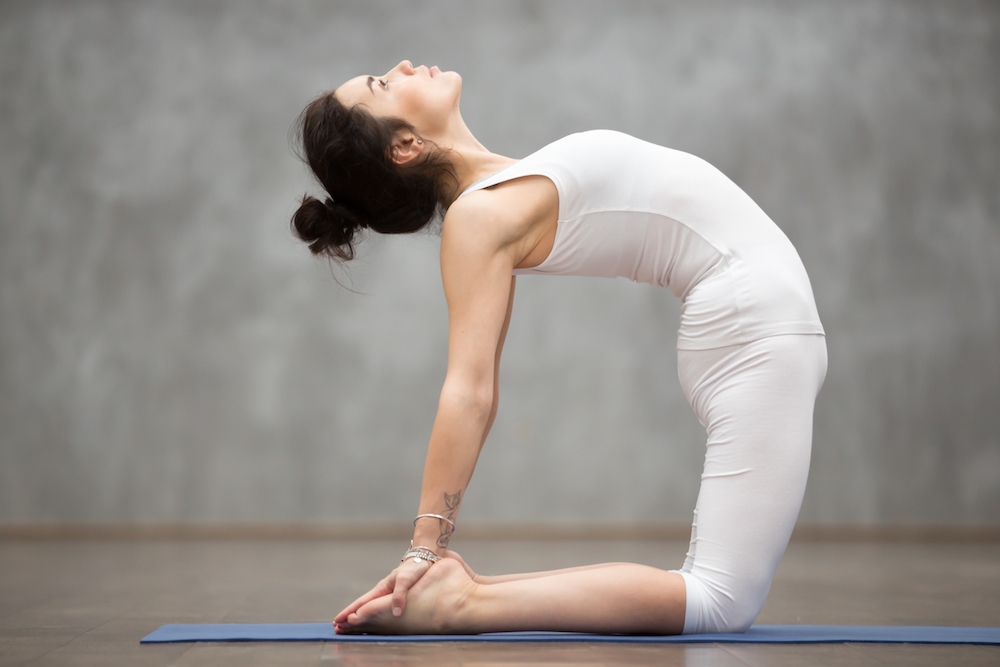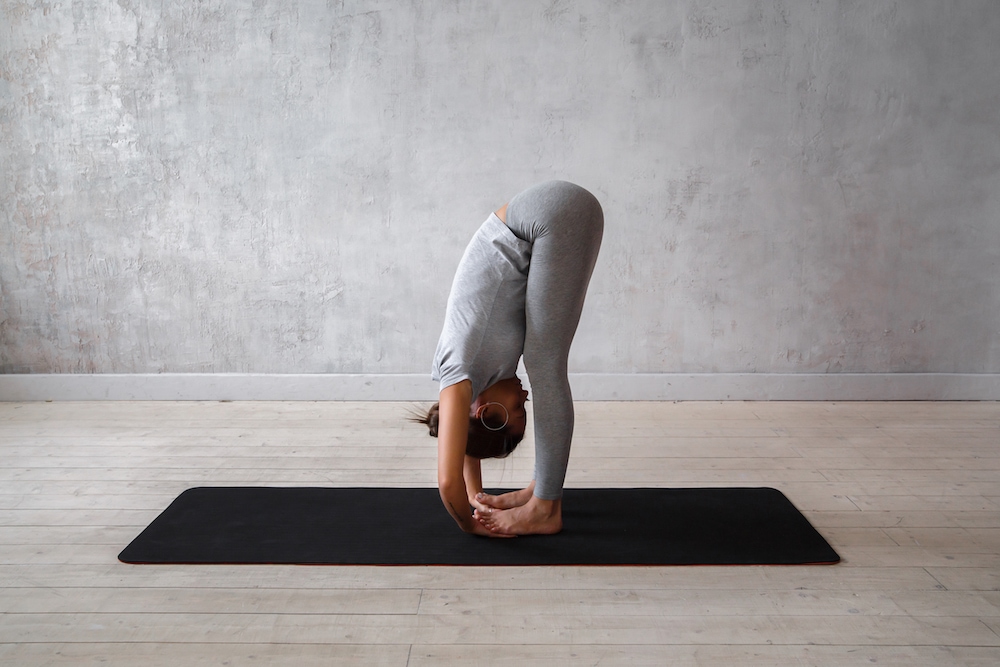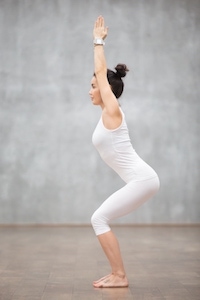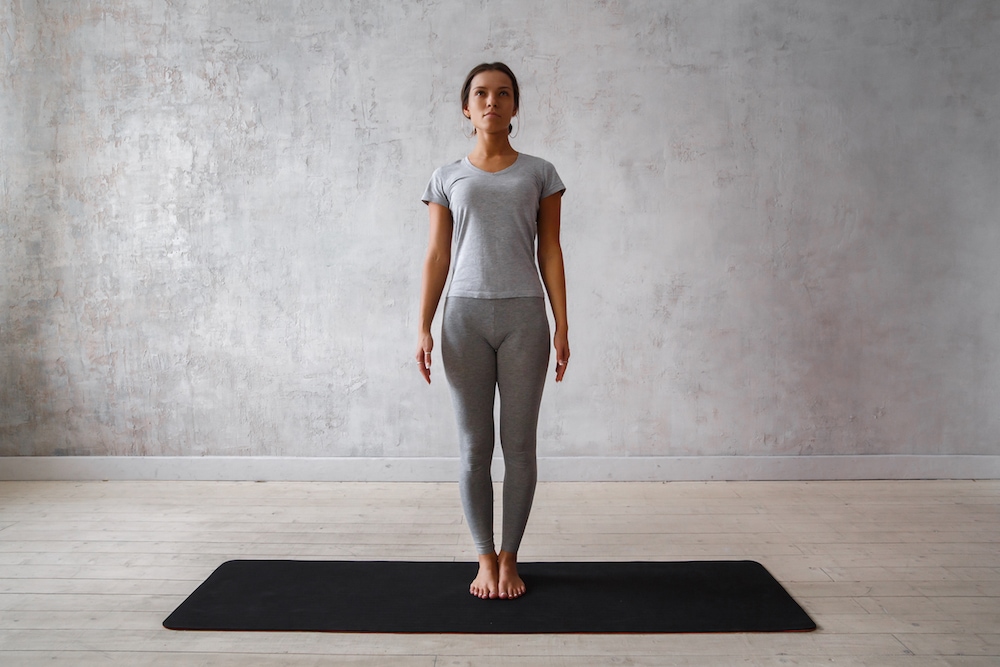
By introducing these six easy-to-master yoga poses into your daily routine, you can lower stress, improve calmness and experience a natural uplift in your mood. Stretching has never felt so good!
The modern 24/7 world means we’re always on, which also means our nervous systems are suffering. Fortunately, yoga can help us retrain our nervous systems and, with regular practice, rewire our brains.
Working with the vagus nerve is extraordinarily popular at the moment. This major nerve of the parasympathetic nervous system sends 80% of signals from body to brain, and scientists are falling over themselves to discover what yoga practitioners have known for thousands of years. Namely, that we can transform our mood by moving and breathing.
Everyone can try yoga. And you don’t need permission from a Himalayan mystic to incorporate it into your daily life. All it takes is a little commitment. Try these simple but highly effective poses to help reconnect your body with your mind.

Camel pose
From a high kneeling position, tuck your toes under, putting your hands on your lower back/sacrum. Gently open the "heart centre" as you tilt your chin and head, leaning backwards. If you want to go further, take your hands to rest on your ankles, keeping balanced, and reach your head downwards towards the feet as you continue to open upwards. Notice what’s happening with your breath. As well as aiming to continue with a long exhalation and low abdominal breath, the camel can be great for training the breath to the back of the lungs, encouraging full thoracic breathing. If it feels good, stay for five complete breaths.
What’s it good for?
Camel can help bring us new perspectives as well as offering the mood boosting benefits of backbends.

Bridge pose
Lie on your back with head, neck and spine aligned, arms alongside the body, palms down. Draw the feet towards your torso with bent knees over the ankles. Gently inhale rising up and exhale back down. After a few breaths, you may want to hold the pose, lifting the hips towards the heavens, opening the chest and regulating the breath. When you’ve had a few complete breaths (five should feel good) gently come back down to the ground and stretch in whatever way feels best for you.
What’s it good for?
It’s a balancing pose, both grounding and energising. Bridge also helps us ponder gaps we’ve already bridged in our lives, encouraging us to do the same with current obstacles.

Standing forward bend pose
With your feet hip-distance apart and facing forward, raise your arms overhead, hinge at the hips, and allow yourself to gently fold forwards to whatever degree feels good. Ensure you have at least a micro-bend in your knees. If you go all the way, rest your hands under your feet, on the floor, around your ankles. If not, shins or higher up is fine. Trust that you’re getting the right stretch for your body in this moment. Aim for five complete breaths. If you find it relaxing enough, holding the pose for three minutes or longer, while inhaling and exhaling at the same quality. To come up, bend the knees a little more and roll up slowly and gently.
What’s it good for?
This pose can help induce the "relaxation response", which is the body’s natural antidote to "fight-or-flight".

Child pose
Traditionally taught by kneeling and allowing the forehead to rest on the floor while your heels remain on the back of the feet, many adult bodies don’t always make the child pose naturally. You might find it easier to take the big toes together and the knees wide apart. You may also want to rest with your hands as a pillow for your forehead, or even wrapped around your torso, first resting on one temple and then gently turning so both sides of the neck feel balanced.
What’s it good for?
As well as offering stress relief, benefits include stretching the spine, hips, thighs and ankles. Yoga specialists say it is especially good when menstruating.

Chair pose
Stand with your feet hip-distance apart, both feet facing forwards. Inhale and raise both arms overhead. Exhaling, bend your knees and bend your upper body forward. Hold for up to three minutes and notice your breath. When ready to come out of it, inhale and straighten your knees. Exhale and release your arms. Hold for three minutes then rest before holding it for three more minutes, resting and holding it for a final three minutes.
What’s it good for?
Wonderful for panic attacks, this pose reminds us that the more grounded we can remain in our lives, the higher we can reach, the more we can achieve. It also strengthens thigh muscles.

Mountain pose
With your feet together or hip-distance apart, face forwards. Notice the weight of the body on the balls of each foot and heel as well as inner and outer edges of the feet. You might want to imagine a mountain behind you, holding, supporting and nourishing you as the ground below keeps you connected. Reach the fingertips down alongside the body and lift at the crown of the head. Notice what’s happening with the breath. If you have low blood pressure or start to feel dizzy, rising up and down onto the balls of the feet allows the calf muscles to act as a pump, aiding circulation.
What’s it good for?
Brilliant for stability, solidity, balance and symmetry, the mountain pose can be practised almost anywhere.
Want to know more? Find a yoga therapist or instructor near you on Therapy Directory

